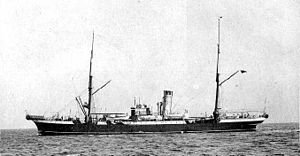
Artist Unknown
Public Domain/Wikimedia Commons
As the world awaits news of who survived Titanic, the White Star Line decides to hire ships to go out and retrieve bodies. Reports of bodies floating in the Atlantic had been reported and White Star wanted to retrieve them as quickly as possible for a number of practical reasons. Ocean currents would eventually move them out of the area, so getting them retrieved as soon as possible would allow families to lay them to rest. Another reason for speed was that sea creatures and birds would start consuming the bodies making identification difficult as well. The cable ship Mackay Bennett was the first ship hired by White Star. Three other ships would be hired as well: Minia (a cable ship), Montmagny (lighthouse supply ship), and the sealing vessel Algerine.
Each ship would carry the necessary supplies to retrieve and embalm the bodies. The Mackay Bennett emptied itself of its normal stores in Halifax, Nova Scotia and brought aboard supplies for its new mission:
- Embalming supplies and coffins (100)
- Chief embalmer of John Snow & Co., John R. Snow Jr.
- 100 tons of ice to store the bodies
- Canon Kenneth Hind of All Saints Cathedral, Halifax
Mackay Bennett left Halifax at 12:28 pm on 17 April 1912. Due to heavy fog and rough seas, it would take four days to reach where Titanic sank. They began recovery at 0600 on 20 April. Bodies were manually recovered by skiffs and brought back to the ship. They recovered 51 bodies but realized they did not have enough embalming supplies on hand. Since the laws at the time required bodies to be embalmed before unloading from ships docking in a Canadian port, they followed a general procedure:
- First class passengers were embalmed and placed in coffins.
- Second class passengers embalmed but wrapped in canvas.
- Third class, crew, and bodies that were too decomposed or disfigured were buried at sea.
- Bodies that were brought back were either transported by relatives to their final resting place or interred in Halifax, Nova Scotia.
Sources:
Books
Behe, George TITANIC: SAFETY, SPEED AND SACRIFICE, Transportation Trails, Polo, IL 1997
Eaton John P. & Haas Charles, TITANIC TRIUMPH AND TRAGEDY, SECOND EDITION, W.W. Norton & Company, New York, New York, 1995 First American Edition
Lord, Walter, A NIGHT TO REMEMBER, Holt Rinehart and Winston, New York, New York, 1955. Multiple revisions and reprints, notably Illustrated editions (1976,1977,1978 etc)
Lord, Walter, THE NIGHT LIVES ON, Willian Morrow and Company, New York, New York, 1986 (First Edition)
Lynch, Don & Marshall Ken, TITANIC AN ILLUSTRATED HISTORY, Madison Press Books, Toronto, Ontario Canada, 1992
Internet
Encyclopedia Britannica, www.britannica.com/search?query=Titanic.
“Encyclopedia Titanica.” www.encyclopedia-titanica.org.
“The Titanic: Sinking and Facts | HISTORY.” HISTORY, 12 Mar. 2024, www.history.com/topics/early-20th-century-us/titanic.







